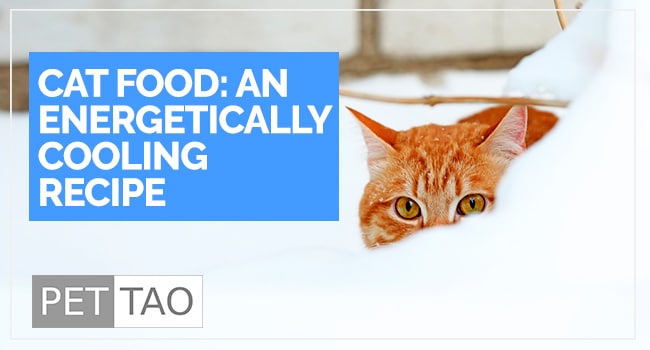Cats needing a cooling cat food recipe have certain characteristics.
For example:
- Is your cat’s appetite either inadequate or ravenous?
- Does your cat suffer from skin rashes, hives or redness?
- Does your cat have red, watery eyes and/or a dry coat?
- Is your cat restless at night, seeking cool places?
If you answered “yes” to several of the above questions, your cat may suffer from Yin deficiency.
Cooling diets balance Yin deficient cats, bringing them into energetic harmony.
What is Yin Deficiency in a Cat?
Yin and Yang are Chinese terms used to describe the opposites in the world. Yin is the cool, the night, the female, the passive, the moon, etc. Yang is the opposite.
The classic signs of Yin deficiency in a cat are:
- Bright red tongue
- Cool seeking
- Excessive thirst
- Dry skin
- Warm to the touch
- Restless at night
The Yin component of the Yin/Yang Theory is cooling. Yin is the moistening and cooling agent of the body. Symptoms like those described above occur in Yin deficiencies. These symptoms occur because there is a lack of cooling and moisture factors. Yin deficiency is the most common deficiency diagnosed in geriatric cats.
Energetically Cooling Foods
Use Eastern Food Therapy to cool an energetically hot cat. You should feed a cat cooling or neutral foods to treat Yin deficiency.
A nutritionally balanced feline diet contains:
- 75% – 90% Protein – from meat
- 10% – 25% Carbohydrates – from grains, vegetables, and fruit
- A minimum of 2% fat
Use the list of foods below to create endless delicious recipe combinations for your furry friend! Mix up the ingredients as needed to create a food that your cat loves. You can easily track the protein, carbohydrate and fat ratios in an online food log like the ones found on Fitbit and Livestrong websites.
You also need to add a taurine supplement to each batch of cat food you make. For cats, taurine is an essential amino acid. Taurine is critical for normal digestion, heart muscle function, normal vision, and to maintain a healthy immune system.
Energetically Cooling Food Choices
Create your own recipe combining the foods below. Make sure to use more cooling foods than neutral foods. For example, if you use a neutral protein, make sure the carbohydrates and fats you use are cool or cold.
Meats/Protein Source
Carp (neutral)
Clam
Cod
Crab
Duck
Eggs (neutral)
Goose (neutral)
Herring (neutral)
Kidney, pork (neutral)
Liver, beef (neutral)
Liver, sheep
Mackerel (neutral)
Oyster (neutral)
Pigeon (neutral)
Pork (neutral)
Quail (neutral)
Rabbit
Sardine (neutral)
Tofu
Turkey
Tuna (neutral)
Whitefish (neutral)
Yogurt
Vegetables/Fruits
Alfalfa
Amaranth
Artichoke (neutral)
Asparagus (neutral)
Banana
Broccoli
Cabbage (neutral)
Carrot (neutral)
Cauliflower (neutral)
Celery
Corn (neutral)
Cucumber
Dandelion leaf
Eggplant
Lettuce
Mushroom, button
Pear
Potato (neutral)
Spinach
Summer Squash
Strawberry
Swiss Chard
Tomato
Watermelon
Yam (neutral)
Grains/Beans/Starch
Barley
Barley sprouts
Black beans (neutral)
Black sesame seeds (neutral)
Broad beans (neutral)
Brown Rice
Buckwheat
Green beans (neutral)
Green peas (neutral)
Kidney bean (neutral)
Millet
Peanuts (neutral)
Red beans (neutral)
Rice (neutral)
Sesame Seed
String beans (neutral)
Soybeans (neutral)
Tofu
Wheat
Bran (wheat)
Flour (wheat)
White rice (neutral)
Fats
Black sesame oil
Honey
Flaxseed oil
Olive oil (neutral)
Peanut oil (neutral)
Sesame oil
Soybean oil
Sample Energetically Cooling Cat Food Recipe
3 pounds meat/dairy (see “meat/protein source” section above)
1 egg
1/3 pound vegetables/fruit (see “vegetable” list above)
1 teaspoon olive oil or flaxseed oil
1/8 pound white potatoes or grains/beans (cooked weight)
1/8 pound brown rice or grains/beans (cooked weight)
Directions:
Debone and chop meat and vegetables.
Place all ingredients in crockpot layering:
- Slow cooking root vegetables on the bottom
- Meat in the middle
- Fast cooking items on top
Top with 1 cup of water.
Cook on low for 4 hours.
In addition, add the following to your pet’s diet:
- One cat multivitamin dose per day
- Calcium supplement 50mg/kg of body weight (22mg/lb of body weight) per day. Some other good choices for calcium are eggshell powder or bone meal.
- Taurine between 250mg and 500mg per cat per day
Feeding Schedule:
Feed roughly 1/2 cup per 10 pounds of body weight twice daily. If your cat is picky, you may want to run the vegetables through a blender with ½ cup of water and create pulp for the base.
When cooked this way, the vegetable pulp mixes with cooked meat juices to create a nutritious broth. Often, cats will lap up the broth more readily than eat small vegetable chunks.
Monitor your cat’s weight. If an undesirable weight loss occurs, please contact your veterinarian immediately so you can make an adjustment in your cat’s feeding/diet plan.
As you can see, cooking for your cat isn’t difficult and can be a rewarding experience for both you and your cat!
Please consult with your veterinarian and use personal judgment when cooking at home for your cat. Even though pet food recalls and the poor quality of some pet foods are a concern, many veterinarians voice concerns over homemade diets. Some vets feel that when fed exclusively, homemade diets may result in vitamin/mineral deficiencies that can adversely affect a pet’s health. If you choose to feed your cat a homemade diet, you must understand and meet your cat’s needs to stay healthy. Please share our recipe with your veterinarian. Your veterinarian can advise you on supplements for your pet’s individual situation. Monitor your cat’s health by observing his/her temperament, skin, coat and waste. If you notice anything strange, contact your veterinarian immediately.








